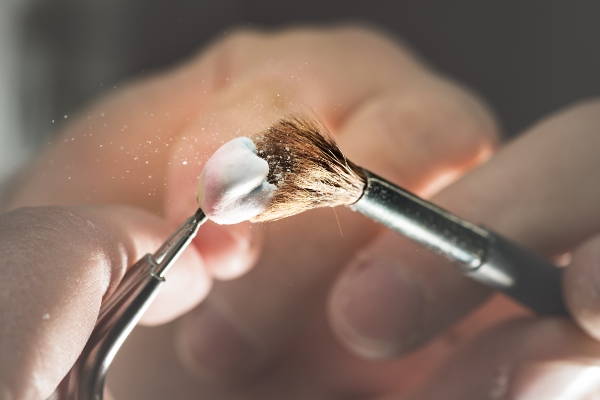Is It Possible To Whiten Dental Crowns?

Dentists use dental crowns to protect or restore damaged teeth. Sometimes, tooth decay becomes too advanced or cracking may weaken the structure of the teeth. In these cases, a dentist may suggest a crown when fillings cannot solve the issue. Crowns are caps made of various materials, including ceramic, resin, porcelain, and metal.
Crown placement is a routine procedure, but many people wonder if they can have their crowns whitened at a later date. The short answer is that crowns do not whiten in the same way that natural teeth do, so it is important to have them properly color matched before placement. Here is what you need to know about crowns and whitening.
The truth behind whitening and crowns
Over time, teeth change color. Coffee, red wine, and tea tend to be the worst culprits when it comes to staining. The color pigments stick to the outer part of the tooth and enamel. Additionally, age changes the colors of a patient's teeth. The teeth have a white outer shell and a yellow dentin beneath it. As the outer enamel becomes thinner, the teeth appear more yellow.
When dentists shape crowns, they choose a color based on the color of the patient's teeth. Generally, the patient's teeth may change colors around the crowns.
How teeth whitening works
Tooth whitening products contain hydrogen peroxide or carbamide peroxide. The bleach breaks the stains into smaller pieces to create a less concentrated color and to brighten the teeth. The chemicals penetrate the tooth's enamel to handle the stains. To change the color of the tooth, the bleach has to seep into the hard structure of the tooth.
To whiten teeth, patients can use stain removal toothpastes, in-office bleaching, or at-home bleaching kits. Toothpastes have mild abrasives to scrub the teeth, along with polishing agents to remove stains, but you will generally get more dramatic results at your dentist's office.
During an in-office whitening procedure, the dentist applies a rubber shield or protective gel to the gums before applying bleach to the teeth. Dentists use a heating lamp for three 20-minute intervals. At-home bleaching kits come with trays customized by the dental office for the patient's mouth. The patient receives instructions on how to apply the bleach. The process can take a few days or a few weeks.
Whitening agents cannot penetrate the crown's materials. In some cases, tooth-colored fillings can undergo whitening treatment with some success, but this is because the tooth around the filling changes color. With veneers, dentists may try to whiten the areas of exposed tooth.
How to whiten dental crowns
Color matching prior to the placement of a crown is important. If you are unhappy with the color of your teeth overall and will be needing a crown, you may want to have a whitening treatment done before getting the crown. Then, your dentist can match the color to your newly whitened teeth.
If patients want a whiter smile long after getting a crown, they can still undergo whitening treatment. Most patients do not have crowns covering all of their teeth. They can whiten the teeth around the crowns. Of course, the crown may still have stains and be a different color from the rest of the smile.
To whiten the crowns, patients have to consider replacing the crown. Dentists can whiten the teeth and then create a new crown based on the whiter smile.
Some patients have crowns for decades, and over time, the restoration becomes dingy or flat. Nowadays, crowns can be bright and white and remain that way longer. If the original color has faded, the dentist removes the crown and cleans the underlying tooth of any stains or decay. The dentist can place a new crown to match the patient's white smile.
Keep in mind, also, that regular professional cleanings can help remove surface stains from crowns as well as natural teeth. So even if whitening agents cannot penetrate the crown, a cleaning can remove stains from coffee, red wine, and other substances. The key is to get your mouth cleaned regularly at the dentist office.
Conclusion
When it comes to dental crowns, teeth whitening processes do not work because the bleaching agent cannot penetrate the exterior of the crown. While patients can whiten the teeth around the crowns, they should replace crowns after a whitening treatment if stains remain and show a significant color difference between natural teeth and crowns.
Request an appointment here: https://www.casasadobesdentistry.com or call Casas Adobes Dentistry at (520) 365-0559 for an appointment in our Tucson office.
Recent Posts
Dental crowns and veneers can both restore the function and appearance of damaged teeth. That damage can take the form of decay, discoloration, chips or cracks, or a crooked appearance. The main difference is that a crown goes over the whole tooth, whereas a veneer only sits on the front. Beyond that, there are pros…
Dental crowns are protective covers or caps that fit over the visible portion of teeth. Over time, teeth endure damage from injuries, tooth decay and other wear and tear. Teeth might become misshapen, cracked, or decayed. Professionals cement the crown atop the tooth to restore its strength, appearance, and size.Crowns may consist of various materials,…
A dental crown is usually chosen as the restoration for a tooth after it has undergone a root canal procedure. Root canal therapy involves removing the soft tissues in a tooth’s pulp chamber to prevent or treat infections.Root canals enable dentists to save extremely damaged or infected teeth. The procedure has a high success rate,…
A porcelain dental crown is beautiful and luminescent and reflects light just enough to look like a natural tooth. Although porcelain crowns look natural, they are, in fact, artificial. Crowns can be shaped precisely in order to restore tooth damage and enhance your smile. This makes them very beneficial both physically and aesthetically.A crown can…


